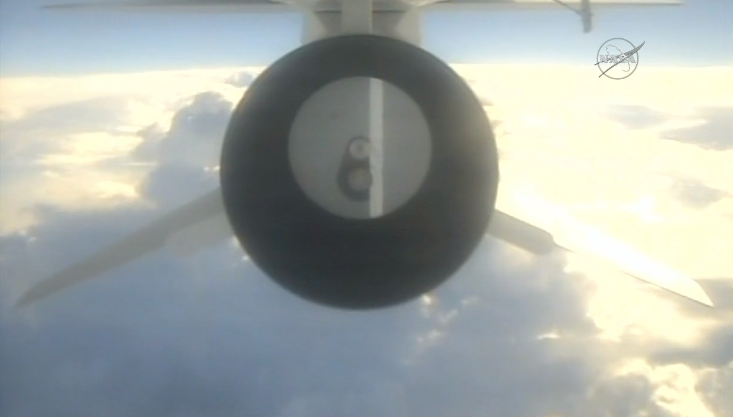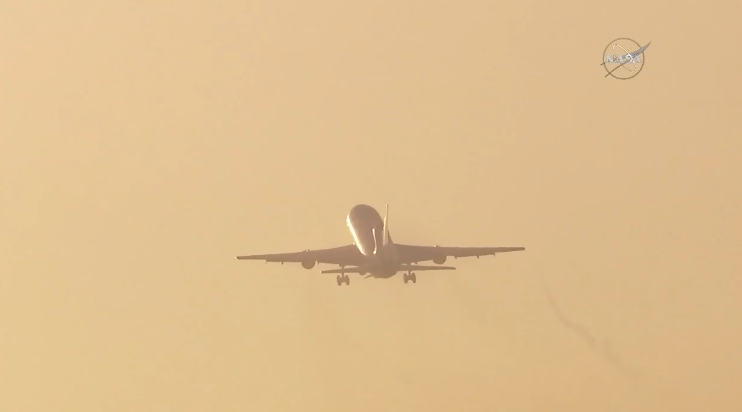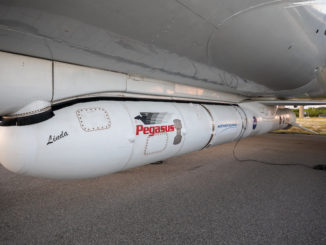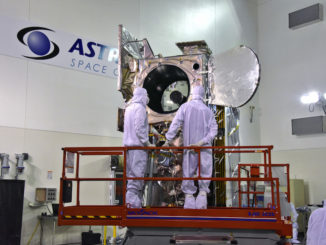Updated at 7:30 p.m. EST (0030 GMT).

Trouble with a hydraulic pump needed to release Orbital ATK’s air-launched Pegasus XL rocket from its carrier jet Monday has delayed the deployment of eight NASA hurricane research satellites until at least Wednesday.
The crew aboard the rocket’s L-1011 carrier aircraft, already airborne flying nearly 40,000 feet (12,000 meters) over the Atlantic Ocean northeast of Cape Canaveral, tried multiple power cycles and old-fashioned elbow grease to get the pump working, but the on-the-fly troubleshooting was unsuccessful.
Dodging thunderstorm cells that could have damaged the rocket’s skin, the airplane’s pilots flew through a predetermined 40-mile by 10-mile (64-kilometer by 16-kilometer) drop box twice in hopes of recovering the balky hydraulic pump and going ahead with the launch of NASA’s $157 million Cyclone Global Navigation Satellite System.
The CYGNSS mission consists of eight microsatellites, each slightly larger than a piece of carry-on luggage, to study the winds deep inside hurricanes, measuring conditions currently unseen to satellites flying overhead.
“Just to give you a quick status, we have cycled all the circuit breakers several times, we’ve beat on the pump a couple of times, we have disconnected, reconnected the plugs a couple of times,” one of the crew members reported to launch control. “We can hear the relay click, but the pump is not coming on.”
The pump drives the mechanism to release the Pegasus XL rocket, and the launch team reported the unit was functioning during tests on the ground.
“It was not meeting the prescribed launch release pressures, indicating a problem with the hydraulic pump,” said Tim Dunn, NASA’s launch director for the CYGNSS mission. “Fortunately, we had a little bit of launch window to work with, so we did a lot of valiant troubleshooting in the air. As you can imagine, everyone wanted to preserve every opportunity to have another launch attempt today, so we did circle around the race track (flight pattern) once, resetting breakers on-board the aircraft, doing what we could in flight to try to get that system back into function again.”
The 60-minute launch window extended until 9:19 a.m. EST (1419 GMT), but all the efforts in the air failed, and managers ordered L-1011 pilot Don Walter to return to base at Cape Canaveral Air Force Station’s Skid Strip runway.

“So that’s why we didn’t launch today,” Dunn said. “(It is) a little bit disappointing for the team. Obviously, you’d love to go on the first attempt. We did battle a lot of weather today, and we were able to fly around, and over and under a lot of precipitation and bad clouds on the way out to the drop point. Fortunately, we’ve got a very dynamic system in Pegasus. It’s a beautiful launch system to allow you that type of flexibility. However, just like any other launch vehicle system that we use, you do have hardware issues that crop up.”
The aborts were the first after takeoff for a Pegasus mission since 2006, when one of the retention pins on the rocket’s tail fins failed to retract in the final minute before launch.
That launch, which carried three NASA technology demonstration satellites into space, was delayed eight days to replace the pin and a control system battery, and to find another slot in the manifest at Vandenberg Air Force Base in California.
The L-1011 carrier plane, one of the last such Lockheed-built jumbo sets still flying, landed back at Cape Canaveral’s Skid Strip just after 9:30 a.m. EST (1430 GMT).
“We’re going to safe all the systems on both Pegasus and the L-1011, and then we’ll really be able to dig in and find out why this hydraulic system did not function as designed today,” Dunn said.
NASA and Orbital ATK officials initially hoped to try to launch the CYGNSS mission again Tuesday, but the space agency said Monday evening that the flight’s next launch opportunity would come no earlier than Wednesday.
“The current targeted Wednesday launch time will allow for a replacement L-1011 carrier aircraft component to arrive from Mojave, California, and be installed, as well as support the required crew rest requirements,” NASA said in a statement.
Wednesday’s one-hour launch window open at 8:20 a.m. EST (1320 GMT), with drop targeted for 8:25 a.m. EST (1325 GMT). The drop box around 100 miles (160 kilometers) east of Daytona Beach remains fixed.
There are not any known missions scheduled on the U.S. Air Force’s Eastern Range until Sunday’s launch of an Atlas 5 rocket with a commercial EchoStar communications satellite. The military-run network of communications, tracking and safety systems needs at least two days to reconfigure between launches.
A weather forecast issued by the Air Force on Monday calls for a 90 percent chance of favorable weather for Wednesday. The only concern is a slight chance of violating the cumulus cloud rule.
Email the author.
Follow Stephen Clark on Twitter: @StephenClark1.



